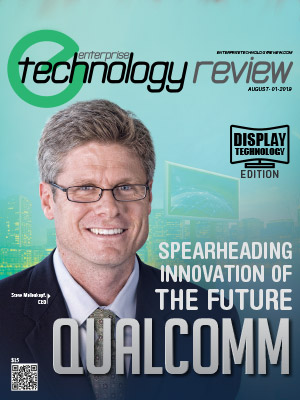Top 10 Display Technology Solution Providers – 2019 From cathode-ray tube to OLED, display technology has taken a notable leap forward. While the science and innovation behind the newest displays differ from manufacturer to manufacturer, together they foretell some exciting trends in display technology that will no doubt impact the display industry.
OLED display technology is at the forefront for a flexible and foldable display. OLED displays are ready to excel in next-generation smartphones by bringing in a thinner, lighter, lower power, and higher performance products with differentiated designs and form factors. OLED has secured a powerful presence within the premium TV market due to picture quality, style differentiation, perfect black, and an infinite contrast ratio.
The foldable display is considered to be the second-generation product for flexible display technology. It provides thin, light, unbreakable, bendable larger screens in a smaller form factor (smartphone/tablet). AMOLED display technology built on plastic substrates leads the quest for a foldable display. Even though the potential is very much promising, there are many challenges including process technology, materials, manufacturing issues, high CAPEX, higher costs, high price for a consumer device, the durability of the products, design acceptance by consumers, and consumer willingness to pay higher prices for the new designs.
OLED's high cost and supply issues, particularly for flexible display can mean an opportunity for LTPS LCD in the near term. LCD is already dominating the smartphone market. Within LCD technology, the market is gradually shifting towards LTPS (low-temperature poly-silicon) away from amorphous-silicon (a-Si). TV manufacturers are switching to higher resolutions (4K, 8K) to offer better picture quality. But adoption of WCG and HDR with 4K resolutions has enabled consumers to check the visual quality differences and experience the value of better performance. Quantum dot-enhanced LCD TVs with 4K, HDR, WCG, and superior picture quality possess the potential to drive TV replacement demand in the next few years. The first generation of quantum dot products is based on (photo-luminescent) enhanced LCD backlights. Next-generation quantum dot photo emissive products can replace the color filter in the LCD with a layer of active Quantum dot emitters increasing efficiency even further with much wider viewing angles.
In recent years, there has been a range of QD technologies and applications available or under development for display such as QDEF replacement films, QD on glass light guide plate, QD color convertor replacing color filters, and Electro Emissive QD. MiniLED can enhance LCD performance by improving contrast ratio, increasing color gamut, reducing response time, and increasing brightness. MicroLED displays are capable of high contrast ratio, very high brightness, fast response time, wide color gamut, high flexibility, low power, and higher transparency. This edition of Enterprise Technology Review features companies that are at the forefront of offering display technology solutions. To assist CIOs in identifying the most reliable companies to partner with, a distinguished panel consisting of CEOs, CIOs, analysts, and Enterprise Technology Review ’s editorial board has assessed and shortlisted some of the most prominent organizations in the industry. We present to you – “Top 10 Display Technology Solution Providers – 2019”

















